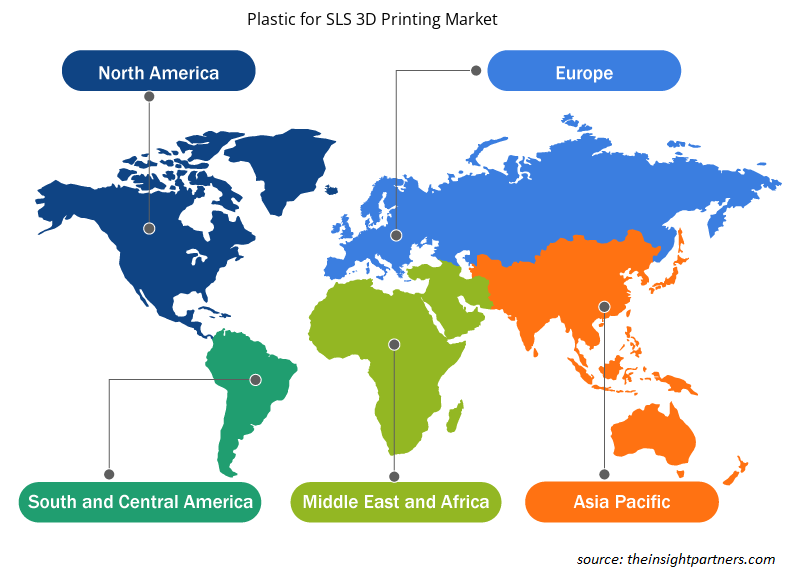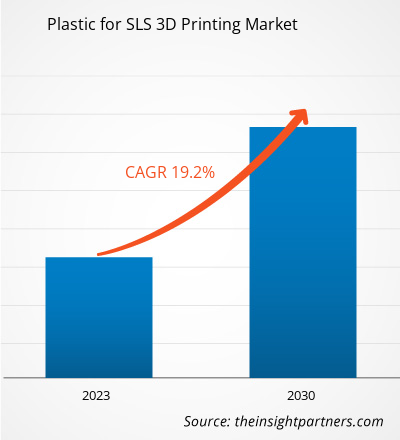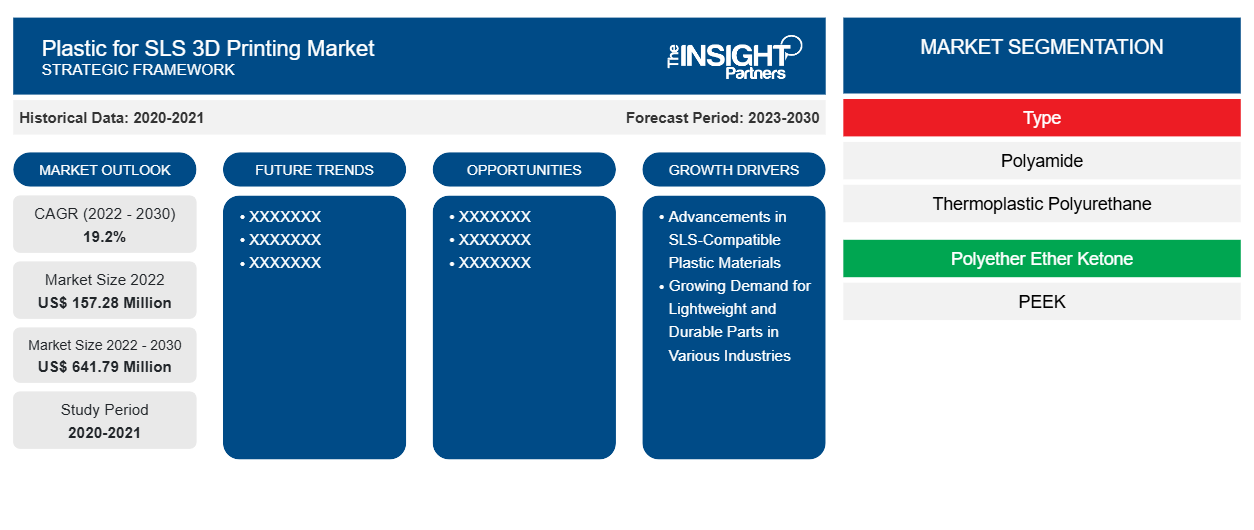[研究报告] 2022 年 SLS 3D 打印塑料市场规模价值 1.5728 亿美元,预计到 2030 年将达到 6.4179 亿美元;预计 2022 年至 2030 年的复合年增长率为 19.2%。
市场分析
选择性激光烧结 (SLS) 是一种增材制造技术,利用高功率激光将聚合物粉末烧结成基于 3D 模型的固体结构。SLS 3D 打印是工程师和制造商的热门选择。SLS 3D 打印最常用的材料是尼龙。尼龙是一种性能卓越的工程热塑性塑料,可用于功能原型设计和最终用途生产。它也是复杂组件和具有高环境稳定性的耐用部件的理想选择。SLS 3D 打印广泛应用于工程、制造、医疗保健等各个行业。推动 SLS 3D 打印市场塑料增长的主要因素是 SLS 兼容塑料材料的进步以及各行业对轻质耐用部件的不断增长的需求。
增长动力与挑战
SLS 兼容塑料材料的进步以及各行业对轻质耐用部件的需求不断增长是推动全球 SLS 3D 打印用塑料市场增长的几个因素。许多公司专注于不断开发具有改进性能的 SLS 兼容塑料材料,例如耐用性、耐热性和柔韧性。例如,惠普和巴斯夫等公司一直在合作开发创新的 SLS 材料。在航空航天领域,减轻重量是提高燃油效率的首要考虑因素,SLS 生产的塑料部件已获得关注。例如,空中客车公司已将 SLS 3D 打印的塑料部件集成到其 A350 XWB 飞机中,包括支架和管道组件,这有助于减轻重量而不会影响强度或安全性。汽车行业也接受了 SLS 塑料零件。因此,各行业对轻质塑料零件的需求强劲增长推动了对 SLS 3D 打印用塑料的需求,从而推动了市场增长。
高品质 SLS 兼容塑料材料的成本可能会成为考虑采用该技术的注重成本的企业的阻碍。虽然 SLS 具有许多优势,包括能够生产具有强度和耐用性的复杂部件,但材料价格可能是决策过程中的一个重要因素。因此,SLS 兼容塑料的高成本限制了它们在不同应用领域的使用,从而阻碍了 SLS 3D 打印塑料市场的增长。
定制此报告以满足您的需求
您可以免费定制任何报告,包括本报告的部分内容、国家级分析、Excel 数据包,以及为初创企业和大学提供优惠和折扣
-
获取此报告的关键市场趋势。这个免费样品将包括数据分析,从市场趋势到估计和预测。
报告分类和范围
“全球 SLS 打印用塑料市场分析和预测至 2030 年”是一项专业而深入的研究,重点关注全球市场趋势和增长机会。该报告旨在概述全球市场,并根据类型、最终用途行业和地理位置对市场进行详细细分。该报告提供了全球 SLS 3D 打印用塑料消费量的关键统计数据,以及主要地区和国家的需求。此外,该报告还对影响 SLS 3D 打印用塑料市场在主要地区和国家表现的各种因素进行了定性评估。它还包括对 SLS 3D 打印用塑料市场领先参与者及其关键战略发展的全面分析。还包括对市场动态的分析,以帮助确定关键驱动因素、市场趋势和有利可图的机会,进而有助于确定主要收入来源。
生态系统分析和波特五力分析提供了对全球 SLS 3D 打印塑料市场的 360 度视角,有助于了解整个供应链和影响市场增长的各种因素。
节段分析
全球 SLS 3D 打印用塑料市场根据类型和最终用途行业划分。根据类型,SLS 3D 打印用塑料市场细分为聚酰胺、热塑性聚氨酯 (TPU)、聚醚醚酮 (PEEK) 等。2022 年,聚酰胺部分在 SLS 3D 打印用塑料市场中占据了相当大的份额。聚酰胺因其卓越的品质和适应性而成为 SLS 3D 打印的首选材料。在用于 SLS 的各种类型的聚酰胺中,聚酰胺 12 (PA12) 特别受欢迎。它主要用于其强度、柔韧性和耐化学性和耐热性,使其成为广泛应用的理想选择。热塑性聚氨酯 (TPU) 是一种用途广泛且在 SLS 3D 打印市场中越来越受欢迎的材料。TPU 是一种弹性体,具有出色的柔韧性、耐用性和弹性平衡,非常适合广泛的应用。在 SLS 3D 打印市场中,PEEK 具有独特的特性组合,使其有别于其他热塑性塑料。
就最终用途行业而言,市场细分为医疗保健、航空航天和国防、汽车、电子等。此外,电子行业在 2022 年的 SLS 3D 打印塑料市场中占有相当大的份额。SLS 3D 打印技术为生产复杂、定制和小型电子元件提供了多种优势。基于塑料的 SLS 3D 打印主要用于制造消费电子产品的定制外壳和外壳。在汽车领域使用塑料进行 SLS 3D 打印的主要优势是它能够生产符合行业严格性能和安全标准的复杂轻质零件。塑料材料在医疗保健领域快速发展的 SLS 3D 打印领域发挥着至关重要的作用。这些多功能聚合物因其生物相容性、易于定制和成本效益而被广泛应用于各种应用。
区域分析
该报告详细概述了全球 SLS 3D 打印用塑料市场,涉及五个主要地区——北美、欧洲、亚太地区 (APAC)、中东和非洲 (MEA) 以及南美和中美洲。欧洲在 SLS 3D 打印用塑料市场中占有相当大的份额,2022 年的价值超过 5500 万美元。欧洲汽车行业一直在寻求减轻汽车重量以提高燃油效率和性能的方法。此外,该地区不断发展的汽车行业预计将推动对 SLS 3D 打印用塑料的需求。到 2030 年,亚太地区 SLS 3D 打印用塑料市场预计将达到 1.1 亿美元以上。亚太地区拥有世界上几个最大的制造业经济体,例如中国、日本和韩国。这些国家正在大力投资 SLS 3D 打印等先进制造技术。该地区还拥有增材制造和 SLS 3D 打印公司,预计这将在预测期内进一步推动 SLS 3D 打印塑料市场的增长。北美 SLS 3D 打印塑料市场预计在 2022 年至 2030 年期间的复合年增长率约为 18%。该地区的 SLS 3D 打印公司的存在预计将进一步推动对 SLS 3D 打印塑料的需求。SLS 3D 打印公司正在制定业务扩展战略,以满足终端行业日益增长的需求。预计该地区汽车和航空航天工业的增长将在未来几年为 SLS 3D 打印塑料市场创造丰厚的机会。
行业发展和未来机遇
以下列出了 SLS 3D 打印塑料市场的主要参与者采取的各种举措:
- 2023 年 6 月,3D Systems 宣布与 SWANY Co Ltd 合作,推动日本采用大幅面颗粒挤出 3D 打印。
- 2021 年 2 月,3D Systems 与 Jabil Inc. 合作推出了 High-Speed Fusion 工业 3D 打印机平台和材料组合。
- 2022 年 10 月,赢创计划通过调整其 INFINAM 聚酰胺 12 (PA12) 粉末,推出二氧化碳排放量低得多的 PA12 粉末,来改善整体生态平衡。
适用于 SLS 3D 打印的塑料市场区域洞察
Insight Partners 的分析师已详细解释了预测期内影响 SLS 3D 打印用塑料市场的区域趋势和因素。本节还讨论了北美、欧洲、亚太地区、中东和非洲以及南美和中美洲的 SLS 3D 打印用塑料市场细分和地理位置。

- 获取 SLS 3D 打印市场塑料的区域特定数据
SLS 3D 打印用塑料市场报告范围
| 报告属性 | 细节 |
|---|---|
| 2022 年市场规模 | 1.5728亿美元 |
| 2030 年市场规模 | 6.4179亿美元 |
| 全球复合年增长率(2022 - 2030 年) | 19.2% |
| 史料 | 2020-2021 |
| 预测期 | 2023-2030 |
| 涵盖的领域 |
按类型
|
| 覆盖地区和国家 |
北美
|
| 市场领导者和主要公司简介 |
|
市场参与者密度:了解其对商业动态的影响
由于消费者偏好的不断变化、技术进步以及对产品优势的认识不断提高等因素,最终用户需求不断增加,推动了 SLS 3D 打印塑料市场快速增长。随着需求的增加,企业正在扩大其产品范围,进行创新以满足消费者需求,并利用新兴趋势,从而进一步推动市场增长。
市场参与者密度是指在特定市场或行业内运营的企业或公司的分布情况。它表明在给定市场空间中,相对于其规模或总市场价值,有多少竞争对手(市场参与者)存在。
在 SLS 3D 打印塑料市场运营的主要公司有:
- 3D系统公司
- 巴斯夫
- 赢创工业集团
- 阿科玛公司
- 恩欣格有限公司
免责声明:上面列出的公司没有按照任何特定顺序排列。

- 获取 SLS 3D 打印塑料市场主要参与者概览
新冠疫情的影响/地缘政治形势的影响/经济衰退的影响
在 COVID-19 疫情爆发之前,全球许多国家都报告了经济增长。主要制造商投资于 SLS 3D 打印用塑料的研发。他们还专注于通过并购策略扩大地理覆盖范围,以满足广泛的客户群。在疫情期间,供应链中断、原材料和劳动力短缺以及运营困难造成了供需缺口,这对 SLS 3D 打印用塑料市场的增长产生了不利影响。制造商报告称,从供应商处采购原材料和成分面临挑战,从而影响了 SLS 3D 打印用塑料的生产率。此外,供应链严重中断和熟练劳动力有限导致的生产短缺在许多地区造成了供需缺口,尤其是亚太地区、欧洲和北美。由于汽车行业需求波动,上述地区也出现了供需缺口。
随着 3D 打印服务的恢复,SLS 3D 打印用塑料的销量有所增加。随着各国政府采取重大措施,例如协调一致的疫苗接种活动,SLS 3D 打印用塑料市场开始复苏。随着汽车、航空航天和国防领域运营的恢复,对 3D 打印材料的需求不断增长。此外,全球电子行业的扩张也推动了对 SLS 3D 打印用塑料的需求。
竞争格局和主要公司
3D Systems Corp、BASF SE、Evonik Industries AG、Arkema SA、Ensinger GmbH、Fiberlab SA、Stratasys Ltd、Sinterit Sp Zoo、EOS GmbH 和 CRP Service SRL 是 SLS 3D 打印塑料市场的主要参与者。
- 历史分析(2 年)、基准年、预测(7 年)及复合年增长率
- PEST和SWOT分析
- 市场规模、价值/数量 - 全球、区域、国家
- 行业和竞争格局
- Excel 数据集
近期报告
相关报告
客户评价
购买理由
- 明智的决策
- 了解市场动态
- 竞争分析
- 客户洞察
- 市场预测
- 风险规避
- 战略规划
- 投资论证
- 识别新兴市场
- 优化营销策略
- 提升运营效率
- 顺应监管趋势























 获取免费样品 - SLS 3D打印市场用塑料
获取免费样品 - SLS 3D打印市场用塑料